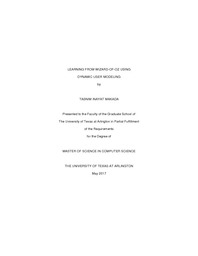
ATTENTION: The works hosted here are being migrated to a new repository that will consolidate resources, improve discoverability, and better show UTA's research impact on the global community. We will update authors as the migration progresses. Please see MavMatrix for more information.
Show simple item record
| dc.contributor.advisor | Makedon, Fillia | |
| dc.creator | Makada, Tasnim Inayat | |
| dc.date.accessioned | 2017-07-03T15:30:45Z | |
| dc.date.available | 2017-07-03T15:30:45Z | |
| dc.date.created | 2017-05 | |
| dc.date.issued | 2017-05-15 | |
| dc.date.submitted | May 2017 | |
| dc.identifier.uri | http://hdl.handle.net/10106/26817 | |
| dc.description.abstract | Socially assistive robotics (SAR) is a field of study that combines assistive robotics with socially interactive robotics where the goal of the robot is to provide assistance to human users through social interaction. The effectiveness of a SAR system basically depends on the user’s engagement in the interaction and the level of autonomy obtained by the system such that it requires no human intervention. The focus of this thesis is to build a SAR system that progressively learns to make autonomous decisions in an online manner, based on human input. An expert/therapist provides guidance to the system during the interaction and learns progressively the therapist’s training strategy. This approach is also known as Learning from the Wizard.
In the field of human–computer interaction, a Wizard of Oz experiment is a research experiment in which subjects interact with a computer system that subjects believe to be autonomous, but which is actually being operated or partially operated by an unseen human being. The user in this case, is interacting with a robot and performing a training task, while having no knowledge of the expert/therapist’s involvement in it. We developed a Wizard Interface, which provides the therapist with a visualization of the learning system and information about the training session, based on which they can modify the action selection mechanism. A main module of the system is the user modeling module. A user model is the collection and categorization of personal data associated with a specific user. Dynamic user models allow a more up to date representation of users. Changes in their learning progress or interactions with the system are noticed and influence the user models. The models can thus be updated and take the current needs and goals of the users into account. Dynamic user modeling allows the system to learn from updated models of the user based on their performance in the current task. In our case, the tasks performed by the user are memory retention tasks, in which the user is given a sequence of characters to remember and repeat in the same order. The difficulty level of the task is dependent on the length of the sequence that the user is asked to remember. To obtain maximum user engagement the task difficulty has to be increased/decreased appropriately with time. Using the user’s performance in each task and the dynamic use model created, a neural network is trained until the system learns to make autonomous decisions, and would require minimal intervention from the expert/therapist. This system intends to greatly reduce the therapist/experts workload from therapy sessions and also create a SAR interaction that the user feels engaged in. | |
| dc.format.mimetype | application/pdf | |
| dc.language.iso | en_US | |
| dc.subject | Wizard of Oz | |
| dc.subject | Dynamic user modeling | |
| dc.subject | Machine learning | |
| dc.subject | Sequence learning | |
| dc.subject | Human-computer interaction | |
| dc.subject | Human-robot interaction | |
| dc.subject | Socially assistive robotics | |
| dc.subject | Robot-assisted therapy | |
| dc.title | LEARNING FROM WIZARD-OF-OZ USING DYNAMIC USER MODELING | |
| dc.type | Thesis | |
| dc.degree.department | Computer Science and Engineering | |
| dc.degree.name | Master of Science in Computer Science | |
| dc.date.updated | 2017-07-03T15:31:48Z | |
| thesis.degree.department | Computer Science and Engineering | |
| thesis.degree.grantor | The University of Texas at Arlington | |
| thesis.degree.level | Masters | |
| thesis.degree.name | Master of Science in Computer Science | |
| dc.type.material | text | |
| dc.creator.orcid | 0000-0001-9717-0839 | |
Files in this item
- Name:
- MAKADA-THESIS-2017.pdf
- Size:
- 1.050Mb
- Format:
- PDF
This item appears in the following Collection(s)
Show simple item record


